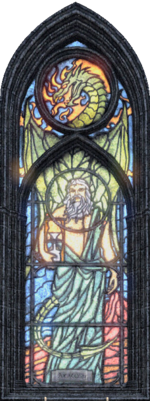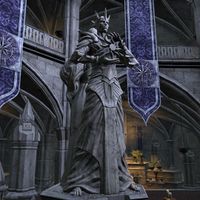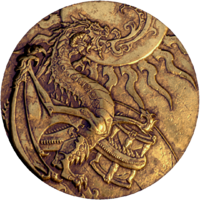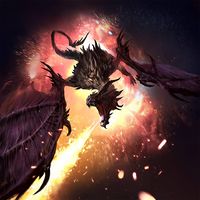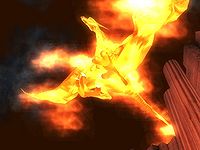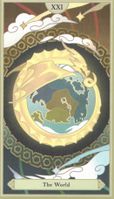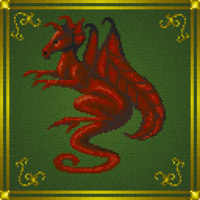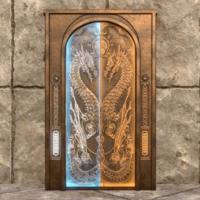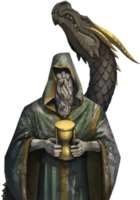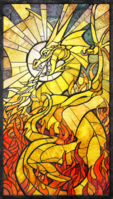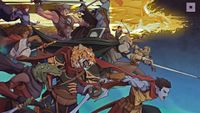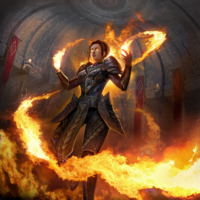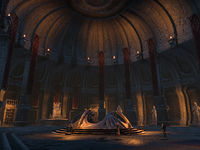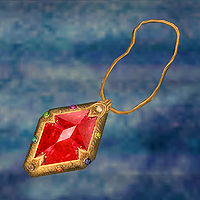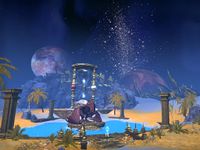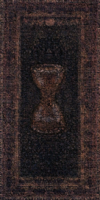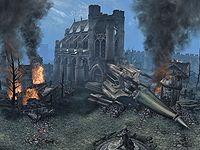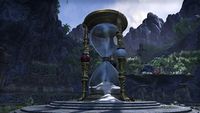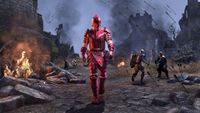Lore:Akatosh
Akatosh, known as Auri-El (or Auriel) to the Mer,[1] Bormahu (Our Father) to the dragons,[2] the great Dragon of Time to the Nedes,[3] Alkosh to the Khajiit, is the chief deity of the Eight or Nine Divines (the prescribed religious cults of Cyrodiil and its provinces). He is present in most Tamrielic religions.[4] His avatar is a golden dragon,[5] and he is often called the Dragon God of Time,[6] and the Lord of the Dragons.[5] He is generally considered to be the first of the gods to form in the Beginning Place, after his establishment, other spirits found the process to be easier and the various pantheons of the world emerged.[1][7][8] The Aedric spirit[1][9] is the ultimate God of the Cyrodilic Empire, where he embodies the qualities of endurance, invincibility, and everlasting legitimacy while promoting the virtues of duty, service, and obedience.[1][4][10] Akatosh is thought to be the father of all dragons,[11] and their leader Alduin was titled "First-Born of Akatosh".[2] Alduin later came to proclaim himself a god, prompting Paarthurnax to turn on him for forsaking his duty to Akatosh,[2] and resulting in history considering Alduin to be the Nordic aspect of Akatosh.[12] Akatosh is the patron of the Akatosh Chantry, the religious order devoted to the worship and glorification of him, who refer to him as the "Great Dragon". Dragon Breaks, such as the Warp in the West and the Middle Dawn, are thought to result from Akatosh's temporary loss of control over the flow of time, or his temporary "breaking", hence the name of the phenomenon.[13][14] Other ancient examples of Dragon Breaks may be found in other cultures, being the result of the Dragon being attacked by spirits and torn apart, like with Alkosh.[15]
Akatosh was involved in the forging of the Covenant with the new Empire of humanity, and his blood was mystically joined with Alessia and her heirs.[6][16] The Amulet of Kings was the primary token of this patronage, and it allowed the new Empire of Cyrodiil to benefit from the stabilizing influence of White Gold Tower, maintaining the barrier between Mundus and the Planes of Oblivion.[6] Nirn and Mundus are thus separated from Oblivion by the Liminal Barriers, which are said to be the creation of Akatosh through the Sublime Brazier, a sacred cauldron described as Akatosh's first light, which stretches to the very heart of Nirn.[17][18] When that barrier was threatened during the Oblivion Crisis, Martin Septim was able to summon Akatosh's spirit and transform himself into the avatar of Akatosh, which appeared in the shape of a giant dragon made of fire.[19] This avatar dragon defeated Mehrunes Dagon, reestablishing the mystical barrier between Tamriel and the Daedric Realms.[6][19] The avatar transformed into a statue, now located inside the ruined Temple of the One.[19]
The story The Four Suitors of Benitah included an intelligence challenge as one of the traits needed to earn Lady Benitah's love. One suitor attempts to demonstrate his intelligence with a mathematical formula proving that Akatosh, Nirn and Oblivion are one. This suitor writes out the mathematical formula proving it is so, but is subsequently defeated by Oin, the protagonist of the story, presenting a mathematical formula that proved the intelligent suitor did not exist, which vaporized the suitor.[20]
A number of religious traditions hold Mara to be the wife or concubine of Akatosh.[4]
In the elven tradition, Anuiel is credited with granting Auriel's Shield and Auriel's Bow to Auriel, which he used the latter to fire the Heart of Lorkhan into what is today Red Mountain.
Syncretism[edit]
In any case, from these two beings spring the et'Ada, or Original Spirits. To humans these et'Ada are the Gods and Demons; to the Aldmer, the Aedra/Daedra, or the 'Ancestors'. All of the Tamrielic pantheons fill their rosters from these et'Ada, though divine membership often differs from culture to culture. Like Anu and Padomay, though, every one of these pantheons contains the archetypes of the Dragon God and the Missing God.
There are multiple examples of Akatosh having parallels in different cultures, with variations on how widely accepted or clear the connections are. There are even claims that Akatosh (as well as Lorkhan) can be found in every single pantheon of worship.[1][4] While listing eight pantheons in Varieties of Faith in Tamriel, Brother Mikhael Karkuxor assigned Akatosh to the first position of the Cyrodiil and Bretony pantheons, Auri-El for the Altmer and Bosmer versions, Alkosh for Elsweyr, Alduin for Skyrim, Satakal for Yokuda, and Almalexia for the Dunmer peoples. The notable omission of an Argonian pantheon was attributed by Mikhael Karkuxor to his "complete inadequacy in reconciling the obscure and contradictory accounts available to me on that subject". The difficulty in breaching Argonian insularism was possibly achieved by Solis Aduro, who provided the first known recording of Atakota from the oral tradition of the Adzi-Kostleel tribe in Children of the Root.
Accepted Aspects[edit]
The following spirits are generally considered to be understood aspects of Akatosh.
Auri-El[edit]
Auri-El is the chief god of most Aldmeri pantheons, with many Altmer and Bosmer directly claiming to be his living descendants.[1] The syncretism between Auri-El and Akatosh is perhaps the most clear and documented. While researching The Alduin/Akatosh Dichotomy, the author High Priest Alexandre Simon presented anecdotal evidence of most High Elves directly conceding that the two beings were the same, "that Auri-El is but Akatosh with a different name, colored by their own cultural beliefs".[12] The Bosmer have similar treatment of him as the King of the Gods, "Auri-El Time Dragon".[4]
Auriel's connection to Akatosh was well known by the Alessian Order. In an attempt to correct this, at the height of their power within the First Era, they would be responsible for the Middle Dawn Dragonbreak. This was done using the Staff of Towers, the ultimate goal of was to remove all traces of elven taint from Akatosh in order to restore him to what they believed was his original humanadic purity which had been corrupted by the "Aldmeri taint".[21][22]
Alkosh[edit]
Alkosh is a pre-ri'Datta Dynasty Anaquinine deity, also known as the Dragon King of Cats, the First Cat, the Highmane, and the Great Cat King of Time. He is depicted as a fearsome dragon, swift and graceful but also powerful and clever, and radiant as the sun, which the Khajiiti say "is just a real big cat". He is the god of Time, and the king of dragons , a variation on the Altmeri Auri-El, and thus an "Akatosh-as-culture-hero" for the earliest Khajiiti. Alkosh's worship was co-opted during the establishment of the Riddle'Thar, but the Dragon King remains popular in Elsweyr's wastelands.
Alkosh is said to be at once the weaver of the tapestry of time and the incarnation of the tapestry itself, the threads that comprise it unspool from the tip of his tail and, should the thread end, there will be nothing, as all exists within time's domain. The Dragon King of Time, like Khenarthi, can see across all the Many Paths of Fate.
The One[edit]
The One was the name of the Supreme Spirit worshipped by the Alessian Order, a strictly monotheistic cult devoted to singularity which ruled the Alessian Empire in the First Era.[23][24][25][22] The Order's concept of the One was rooted in the belief that the God of Time Akatosh is of unitary essence, as proven by the monolinearity of Time. Furthermore, they believed that his sibling Shezarr is "singularly misplaced" and therefore doubly venerated.[25]
World-Eater Aspects[edit]
The following spirits govern the sphere of the End of Times, which Akatosh has disputed ties to.
Alduin[edit]
In contrast to nearly universal acceptance of Auri-El and Alkosh as local variants of Akatosh, the syncretism of Akatosh and Alduin may be among the most controversial of examples. Also unlike previous examples, Alduin is not the chief god of the Nordic pantheon. Instead, Alduin is the bringer of the end times, and is known by the sobriquet "The World Eater".[4]
The origins of the ties between the two on the Imperial side can be traced to the efforts of the High Priestess of Akatosh Alessia, who was faced with the difficult task of finding a working compromise between the Aldmeri and Nordic pantheons. Although this particular controversy was primarily inspired over the position that would be claimed by the other universally present god, Lorkhan, the Nords were unwilling to allow for the worship of an elven pantheon, and her own subjects would have most likely revolted at a forced conversion to the Nordic pantheon. This resulted in the creation of the Eight Divines, with Shezarr being excluded from the total count as the "Missing God", but still venerated.[26][27]
As for the Nords, their distaste for Alduin can be traced to their early history. The earliest recordings of the modern Nordic religion were "The Old Ways", which worshiped various animal gods, including dragons, and featured clear parallels for the later Eight Divines. However, the Dragon Cult came to prominence with support from actual dragons, leading to their rule over the early Nords. This would culminate in the Dragon War, where the Nords overthrew the Dragon Cult.
As for Alduin himself, he is the self-proclaimed firstborn of Akatosh, claimed the lordship of Akatosh as his own, and ruled over the Nords during that period of time.[2] The cruelty of this time period left a lasting impression on Nordic society, and Alduin's own claim to being Akatosh created a natural aversion for the Imperial pantheon featuring him as their chief god. When Skyrim was incorporated into the Empire, the Imperials brought with them Akatosh, who the Nords saw as Alduin.[28] This was acknowledged as a mistake originating from the founding of the Eight Divines, that had yet to be fully corrected by the Second Era by the Bishop of Akatosh Artorius Ponticus, who described it as a "brutal misunderstanding".[27]
However, descriptions of Alduin in the Third Era continued to be rather contradictory, in spite of a clear rejection of him as their chief god, and researchers such as Brother Mikhael Karkuxor noting Alduin only "superficially resembles his counterpart in the Nine Divines". The confusion pertaining to Alduin is exasperated by comments from the missionary arm of the Imperial faith, the Imperial Cult. One missionary stationed in Solstheim described Alduin as a "heathen god".[29] In Bruma, Arentus Falvius, the Primate of the Great Chapel of Talos, similarly concluded that Nordic beliefs were antithetical to the Nine Divines.[30]
By the Fourth Era, the positions on the confusion had seemingly reversed. While leaders of Akatosh's faith in the Second Era, such as Artorius Ponticus, noted that the confusion laid with the Nordic population not understanding the distinction between the two, the Akatosh Chantry of the Fourth Era was now the one expressing the singularity of the two in spite of protests from the Nords. In The Alduin/Akatosh Dichotomy, High Priest Alexandre Simon interviewed the Nordic population, who repeatedly asserted that Alduin and Akatosh were two different beings entirely, and that Akatosh was "first among the Divines, perseverance personified and, more than anything, a force of supreme good in the world". Ultimately, he rejected this explanation, and reiterated that Alduin and Akatosh were certainly one and the same. Another example of this comes from a book written by a Nord rejecting syncretism between Alduin and Akatosh while still accepting Akatosh as a good god worthy of worship, Alduin is Real, and He Ent Akatosh.[12][31]
In 4E 201, Alduin reappeared from his banishment through time. He began to raise long-dead dragons from death, reinstate his draconic rule, and eat the world. The Last Dragonborn appeared and defeated Alduin, saving Skyrim.[11] After Alduin's defeat, his former lieutenant-turned-rival Paarthurnax spoke of Alduin's doom. He said Alduin had doomed himself by improperly claiming the lordship of Akatosh[2], showing that the dragons themselves see Alduin as distinct from Akatosh.
Alkhan[edit]
The ancient Khajiit acknowledge a World-Eater Dragon. He is a Wandering Spirit known as Alkhan, The Scaled Prince, and the Firstborn of Akha. Texts that predate the Riddle'Thar Ephiphany claim that Alkhan was born when Akha bred with a demon of fire and shadow. Alkhan grew in size with each soul he ate, and ever hungered for the crown of Alkosh. He was slain by Lorkhaj and his companions, but will return one day along the Many Paths.[32]
Thartaag[edit]
The Skaal recognize a version of the Adversary who will show up at the End of Seasons under the name Thartaag the World-Devourer, easily comparable to Alduin.[33]
All-Maker[edit]
In a claim that is seemingly at odds with the idea of Alduin being connected to the Skaal's malevolent Adversary, some sources instead postulate that the benevolent All-Maker of the Skaal is a distant echo of Alduin.[34]
Satakal[edit]
Similar to how Alkosh is a variant of Auri-El, Satakal is seen as a variant of Alduin. Like Alduin, Satakal brings about the end of the world, allowing for the next one.[4][1]
Atakota[edit]
Atakota is a being that was recorded from the oral tradition of the Argonian Adzi-Kostleel tribe by Solis Aduro, and has some resemblance to other known variations of Akatosh. These aspects include being responsible for time, arguably the most primary trait of Akatosh, and taking part in a cycle of beginning and ending things.[35]
Dubious Aspects[edit]
The following spirits are not generally tied to the Time Dragon, but are likened to him on occasion or share similarities to him.
Ruptga[edit]
Ruptga of the Yokudan pantheon who like Akatosh, is a chief of the pantheon, is often conflated with the Time Dragon.[36] The Forebears who acknowledge Akatosh as their chief claim that the Crowns know Akatosh as Tall Papa. Similarly, to the Forbears Akatosh is the father of Zeht whereas to the Crowns Ruptga is this father.[37] On the other hand, some sources claim Ruptga came into being after Akatosh' perch from Eternity.[1]
Almalexia[edit]
Most traces of Akatosh disappeared from ancient Chimer legends with their exodus due to his association with the Altmer, although they would return in a fashion with the Dunmer. Akatosh's aspects of immortality, historicity, and genealogy would resurface in Almalexia, the most popular traits of Akatosh being seen in Morrowind's most popular divine Tribunal. Although female instead of male, Almalexia also takes on the role of a progenitor figure like Akatosh.[4]
Peryite[edit]
Peryite is a spirit in the Reachfolk pantheon, sharing traits with Akatosh, such as ties to time, strict natural order, and draconic symbolism. This suggests cultural connections between the early ancestors of Men and Mer in northwestern Tamriel.[38] After imperialization and the loss of independence, some Reachmen embraced the worship of the Eight Divines, including Akatosh, believing that certain aspects of their traditional practices were best left in the past.[39][40][41]
Tenets[edit]
The Tenets of Akatosh reflect the qualities of his sphere, and these are expected of his followers who truly believe in him. Endurance: gives Akatosh the ability and strength to continue and last, this is directly associated to his role as the god of time. His followers are expected to endure in a similar matter despite whatever fatigue, stress or adverse conditions they come across, and this reflects Akatosh's lasting quality. Invincibility: another key trait of Akatosh is he cannot be defeated, conquered, or subdued, and his followers who truly believe in him cannot be either. This is Akatosh's indomitable quality. Everlasting Legitimacy: is a quality that must be examined, as it not only reflects the eternal aspect of Akatosh, but also his reverence for law, reason, and the ruling principles of heredity. As such, nothing sanctioned or blessed by Akatosh can be considered unjustified, and reflects Akatosh's lawful quality.[42]
Worship[edit]
The Rite of Akatosh is an endeavor held by Cyrodiilic elders during the Old Life Festival in preparation for the New Life Festival, in which their party goes on a pilgrimage to rid the nearby forests of "Old Life", monsters like Goblins, Ogres, and trolls. The party then challenges the manifested Avatar of Akatosh. By successfully defeating this avatar, the elders hope the God of Time will grant them youth or more time, to be at peace, or that the feat will grant them respect.[43] The phenomenon of Solar eclipses is sometimes thought to represent the loss of the favor of Akatosh, and to be possible to undo with diligent prayer to that deity.[44]
Ardent worshipers of Akatosh use ritual implements associated with the deity such as sacred oils and seeds, sanctified metalworking tools blessed by Akatosh and Zenithar, golden dragonscales or captured ever-burning dragonflame, to craft implements associated with the deity, such as golden scales resembling those of Akatosh which they morph their own skin to resemble through magic, or paladin's armor.[45]
The Cuirass of the Crusader is thought to have been created by either Mara or Akatosh. Champions of the deity have been known to sometimes receive blessings of greater strength, being urged to trust in the Nine when their owns strength fails them.[46]
The Ten Aphorisms of Akatosh are known to be recited by followers of Akatosh.[47]
Five Commandments of Akatosh[edit]
These commandments are those Akatosh expects all of his worshipers to follow and these commands are taught even to the faithless.
- First Commandment: "Obey your Emperor" this command comes from the fact the Empire and Akatosh go hand in hand.
- Second Commandment: "Study the Covenants", this command is studying the agreements made by Akatosh and his mortal followers, everyone that follows are urged to study these.
- Third Commandment: "Worship the Eight" Akatosh isn't a Jealous God, and expects all his followers to worship and revere the Eight.
- Fourth Commandment: "Do your duty." Akatosh expects everyone to do their duty and be responsible, failing to meet obligations is considered a sin.
- Fifth Commandment: "Heed the commands of the saints and priests." Akatosh prefers hierarchy and order and expects his followers to follow the Church's Hierarchy.[42]
Planet and Associated Realms[edit]
The planet Akatosh, sometimes called AKHAT, is one of the Dominion Planets found in the skies of Mundus. According to the Warrior-Poet, Vivec, it is one of the eight worlds known to the Dwemer. There are no known satellites orbiting around it, but it marks the eye of the Warrior constellation. As with all astral bodies seen in the skies above Nirn and their corresponding deities, the planet Akatosh is believed to be the plane of the god Akatosh as well as the god himself, as seen from the mortal plane. It is said to actually be a different plane of existence in its own right, infinite in size and mass, with its appearance as a sphere being only a visual phenomenon caused by mortal mental stress. Akatosh is said to have ruled from here before Convention took place in ME 2500. Though scholars largely agree no mortal beings live on Akatosh or Arkay, Azandar al-Cybiades theorized that the power Ayleid Wells reroute back towards the heavens was being collected by someone. The 33rd sermon in Vivec's thirty-six lessons calls Akatosh the north-pole-star of warriors, which references its position on the Warrior constellation.
The Spilled Sand is an obscure realm of existence associated with Alkosh.It consists of an endless expanse of sand interspersed with an oasis of golden trees, and a colossal slumbering golden dragon with scales of pure gold. The twin moons, Jode and Jone, can be seen in the sky alongside a series of stars. The realm is described as not a place but rather a "story that has and will be told time and time again" and "myth made manifest", it is said to exist at once within and outside the tapestry of time, and beyond even the Sands Behind the Stars.[48][49] When questioned on whether the Spilled Sand is the realm of Alkosh itself, Ja'darri would not outright confirm it, answering instead that Alkosh is both weaver and embodiment of time's tapestry and all always exist within time's realm regardless of where they are.[49] The Mask of Alkosh allows for one to journey to this realm when awoken via the blood of a dragon.[50]
The "myriad kingdoms of Akha along the Many Paths", the realities beyond and surrounding Aurbis are thought to be ruled over and safeguarded by Alkosh, who inherited the role and crown of Akha.[15][51][52]
Gallery[edit]
Depictions[edit]
-
Akatosh lends his symbol to the crest of Daggerfall (Daggerfall)
Other[edit]
-
The guardian of the Sublime Brazier, imbued with the power of Akatosh (Legends)
-
An Akatosh Chantry banner of Akatosh (ESO)
Notes[edit]
- The French translation of the book The Monomyth claims Satakal is Akatosh, similarly to the mention of Jills in the French translation of A Child's Tamriel Bestiary. This claim is also present in The Morrowind teaser posted in 1999 on the official forums leading up to the release of TES3:Morrowind (Taken from an official Bethsoft post on The Storyboard 09/07/99).French Translation of "The Monomyth". Retrieved 2025-01-23.</ref>[UOL 1]
See Also[edit]
References[edit]
- ^ a b c d e f g h The Monomyth
- ^ a b c d e Paarthurnax's dialogue in Skyrim
- ^ Tales of Abba Arl: The Ox's Tale — Abba Arl
- ^ a b c d e f g h Varieties of Faith... — Brother Mikhael Karkuxor of the Imperial College
- ^ a b King Edward
- ^ a b c d The Amulet of Kings — Wenengrus Monhona
- ^ Pocket Guide to the Empire, 1st Edition: Invocation — Imperial Geographical Society, 2E 864
- ^ Before the Ages of Man — Aicantar of Shimerene
- ^ For my Gods and Emperor — Imperial Cult
- ^ Ten Commands: Nine Divines
- ^ a b Events of Skyrim
- ^ a b c The Alduin/Akatosh Dichotomy — Alexandre Simon, High Priest of the Akatosh Chantry, Wayrest
- ^ The Warp in the West — Ulvius Tero
- ^ Where Were You ... Dragon Broke — Various
- ^ a b The Wandering Spirits — Amun-dro, the Silent Priest
- ^ Trials of St. Alessia
- ^ Dialogue from the Drake of Blades in ESO
- ^ The Sublime Brazier — Augusta Purusius, Associate Historian, Imperial Academy of Records and Histories
- ^ a b c Events of Oblivion
- ^ The Four Suitors of Benitah — Jole Yolivess
- ^ Gahgdar's dialogue in ESO
- ^ a b Vindication for the Dragon Break — Fervidius Tharn, Arch-Prelate of the Maruhkati Selective
- ^ Pocket Guide to the Empire
- ^ Glenumbria: Alessian Orders
- ^ a b The Exclusionary Mandates
- ^ Shezarr and the Divines — Faustillus Junius
- ^ a b Artorius Ponticus Answers Your Questions — Bishop Artorius Ponticus
- ^ Divines and the Nords — High Priest Ingurt
- ^ Jeleen's dialogue
- ^ Arentus Falvius' dialogue
- ^ Alduin is Real — Thromgar Iron-Head
- ^ The Wandering Spirits — Amun-dro, the Silent Priest
- ^ Aevar Stone-Singer
- ^ The Guardian and the Traitor — Lucius Gallus
- ^ Children of the Root — Solis Aduro
- ^ The Improved Emperor's Guide to Tamriel: Hammerfell — Flaccus Terentius, 2E 581
- ^ Varieties of Faith in Tamriel — Brother Mikhael Karkuxor of the Imperial College
- ^ Great Spirits of the Reach: Volume 4 — Vashu gra-Morga, Chief Daedrotheologist at the University of Gwylim
- ^ Belchimac's dialogue in Skyrim
- ^ Cedran's dialogue in Skyrim
- ^ Degaine's dialogue in Skyrim
- ^ a b Worship of the Dragon God
- ^ The Rite of Akatosh event and related Rulings in Castles
- ^ Eclipse rulings in Castles
- ^ Soulfire Dragon Illusion's Morphing Collectible descriptions in ESO
- ^ Priory of the Nine quest in Oblivion: Knights of the Nine
- ^ Yadugar's dialogue in ESO
- ^ Nahfahlaar's dialogue in ESO: Dragonhold
- ^ a b Ja'darri's dialogue in ESO: Dragonhold
- ^ The Dragonguard quest in ESO: Dragonhold
- ^ Leramil's dialogue in ESO
- ^ Ithelia's dialogue in ESO
Note: The following references are considered to be unofficial sources. They are included to round off this article and may not be authoritative or conclusive.
|
||||||||||||||||||||||||||
|
|||||||||||||||||||||||
|
|||||||||||
|
||||||||||||||||||||||||||||||
|
||||||||||||||||||||||||||||||||||||
|
|||||||||||||||||||||||
